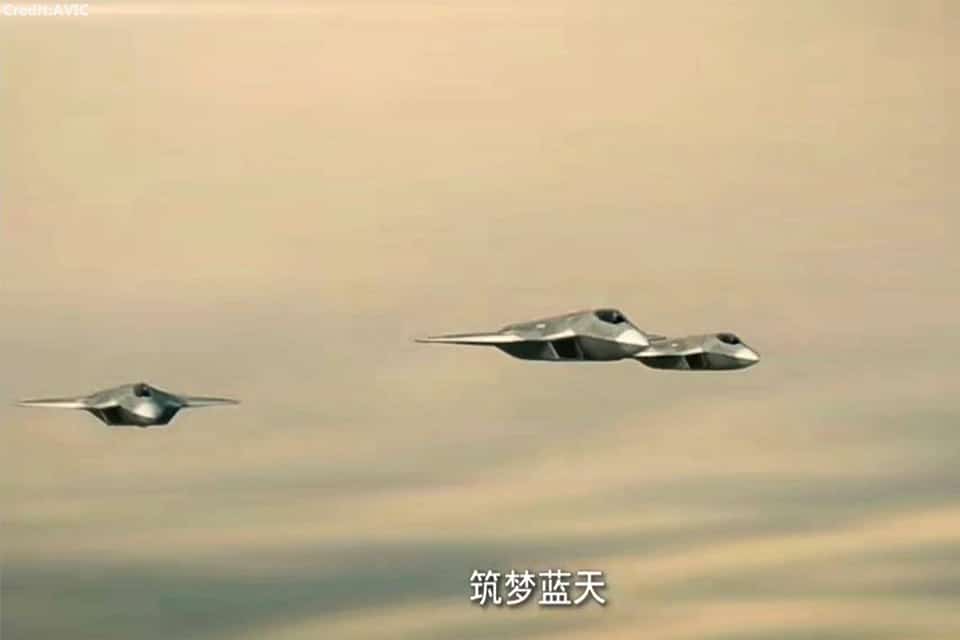Aerospace
Meet China’s 6th-Generation Stealth Fighter jet

China is in the process of developing a sixth-generation fighter aircraft, which could potentially make its debut as early as 2035. This development is poised to significantly alter China’s military strategy and reshape the landscape of aerial warfare.
The upcoming sixth-generation fighter (J-25 or J-28) will stand out for its greater speed, higher operational altitude, and improved radar stealth capabilities. These characteristics will help the aircraft succeed in ground attack and fast penetrating air missions.
One striking aspect of China’s upcoming sixth-generation stealth fighter is its apparent similarity to the Next Generation Air Dominance (NGAD) stealth aircraft being developed by the United States: a tailless design. This innovative approach marks a departure from conventional aircraft configurations.
The Aviation Industry Corporation of China (AVIC) has unveiled a video featuring CGI concept art of this futuristic stealth fighter. The depicted twin-engine jet fighters exhibit distinctive low-reflective diamond-shaped wings, reminiscent of Northrop Grumman’s YF-23 Black Widow demonstrator fighter. Moreover, these aircraft feature a blended-wing body configuration and notably lack a traditional tail structure.
This finless, tailless aircraft is referred to as a “blended wing-body design.” This arrangement has various advantages, including the capacity to generate more lift, attain longer operational ranges, and consume less fuel. The greatest significant gain, though, is most likely its greater stealth capabilities.
Traditional vertical structures, such as tails and fins, which help with speed, maneuverability, and vectoring, also increase the radar return signature available to against air defenses. The absence of these features enhances the aircraft’s stealth, making it more challenging for adversaries to detect and track.
It is crucial to bear in mind that the artwork and mockups presented at this stage should be interpreted with caution. Many conceptual designs never progress to production and those that do invariably undergo significant revisions.
The precise capabilities of a sixth-generation fighter are unknown, but it is widely expected to outperform its predecessors in a variety of ways. This includes more powerful armament systems, enhanced stealth technologies, artificial intelligence integration, and a variety of other high-end capabilities that will position it as a formidable asset in future air warfare scenarios.
The J-20 of China is now being upgraded to close the gap between it and the F-22 and F-35 of the US. The design includes many elements that have been “copied from the F-22 and F-35, including nose cone shaping, the electro-optical targeting system (EOTS) under the nose, and the side-mounted [diverter less supersonic inlet] intakes,” according to a report.
As a result, the United States, refusal to share much about its sixth-generation jet, could be related to concerns about other countries, “stealing” the design and technical data. An understanding of exterior structures may provide some insight, into the next generation of fighters.

Aerospace
Boeing Transfers Rocket Stage to NASA, Paving Way for Human Moon Mission

Boeing has achieved a significant milestone by providing NASA with the second core stage of the Space Launch System (SLS) rocket.
This crucial component, crafted at NASA’s Michoud Assembly Facility (MAF), is set to propel the Artemis II crew into lunar orbit, marking humanity’s return to deep space after a 50-year hiatus.
The monumental Boeing-built rocket stage, the largest element of the Artemis II mission, will embark on a journey aboard the Pegasus barge, traveling 900 miles to NASA’s Kennedy Space Center.
Comparison of two legendary aircraft B777x vs B747 aircraft:Click here
Upon arrival, it will be meticulously integrated with other essential Artemis II components, including the upper stage, solid rocket boosters, and NASA’s Orion spacecraft within the iconic Vehicle Assembly Building. This intricate integration process is a vital step toward the eagerly anticipated Artemis II launch, slated for 2025.
“Boeing-built products helped land humankind on the moon in 1969, and we’re proud to continue that legacy through the Artemis generation,” remarked Dave Dutcher, vice president and program manager for Boeing’s SLS program. “Together, with NASA and our industry partners and suppliers, we are building the world’s most capable rocket and paving the way to deep space through America’s rocket factory in New Orleans.”
NASA, Lockheed Martin Reveal X-59 Quiet Supersonic Aircraft:Click here
The delivery of Core Stage 2 marks a significant achievement in the evolution of the SLS rocket. Towering over 200 feet and powered by four RS-25 engines, this core stage, coupled with two solid-fueled booster rockets, will generate a staggering 8.8 million pounds of thrust. This immense power is crucial to launching Artemis II and future missions into the vast expanse of space.
The SLS rocket stands unparalleled in its capability to transport both crew and substantial cargo to the moon and beyond in a single launch. Its extraordinary capacity will facilitate the delivery of human-rated spacecraft, habitats, and scientific missions to destinations including the moon and Mars, ushering in a new era of space exploration.
-

 Travel1 week ago
Travel1 week agoAir India to Expand US Operations with Three New Routes After a Decade
-

 Travel2 weeks ago
Travel2 weeks agoWhy We Should Avoid These Stamps in a Passport
-

 Airlines1 month ago
Airlines1 month agoInvestigations Reveal Fake Chinese Titanium in Boeing and Airbus Jets
-

 Tech4 weeks ago
Tech4 weeks agoChina’s CATL Plans 1,800-Mile Electric Plane Launch by 2027
-

 Airport3 days ago
Airport3 days agoTop 10 Largest Airports in the World by Size
-

 Aerospace4 weeks ago
Aerospace4 weeks agoChina’s Fighter Jets Turn Wings into Autonomous Drones
-

 Airlines4 days ago
Airlines4 days agoAir India Rolls Out A350s for Delhi-New York JFK and Newark Routes
-

 Defence3 weeks ago
Defence3 weeks agoBoeing Enhances Chinook with New Engines and Block II Upgrades at $96 Million







